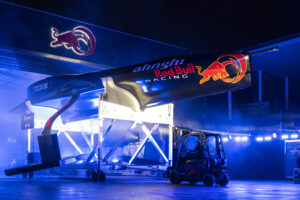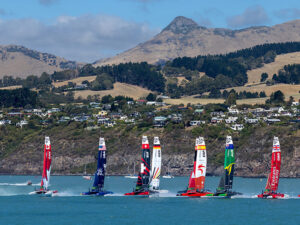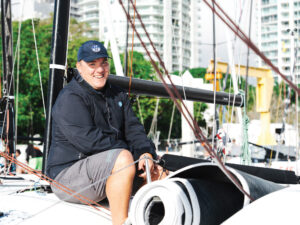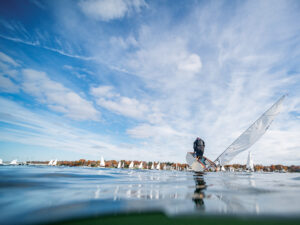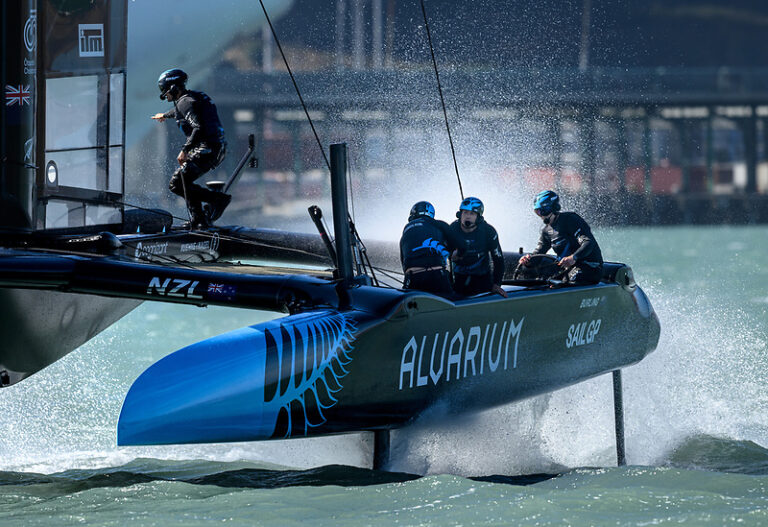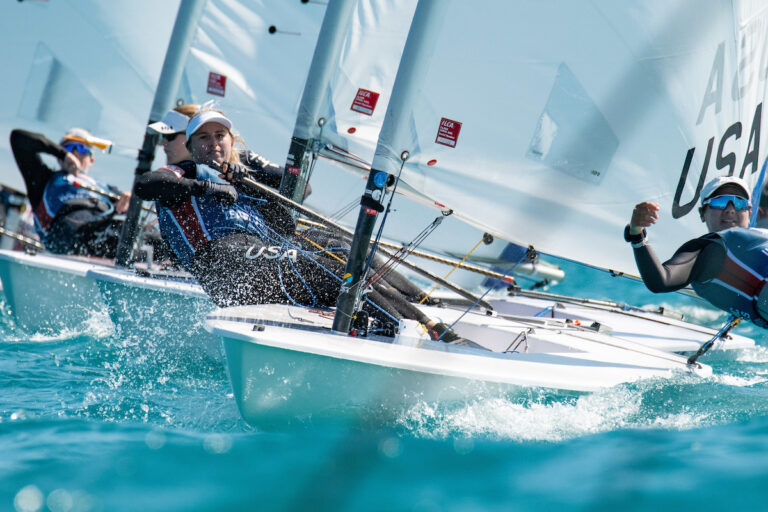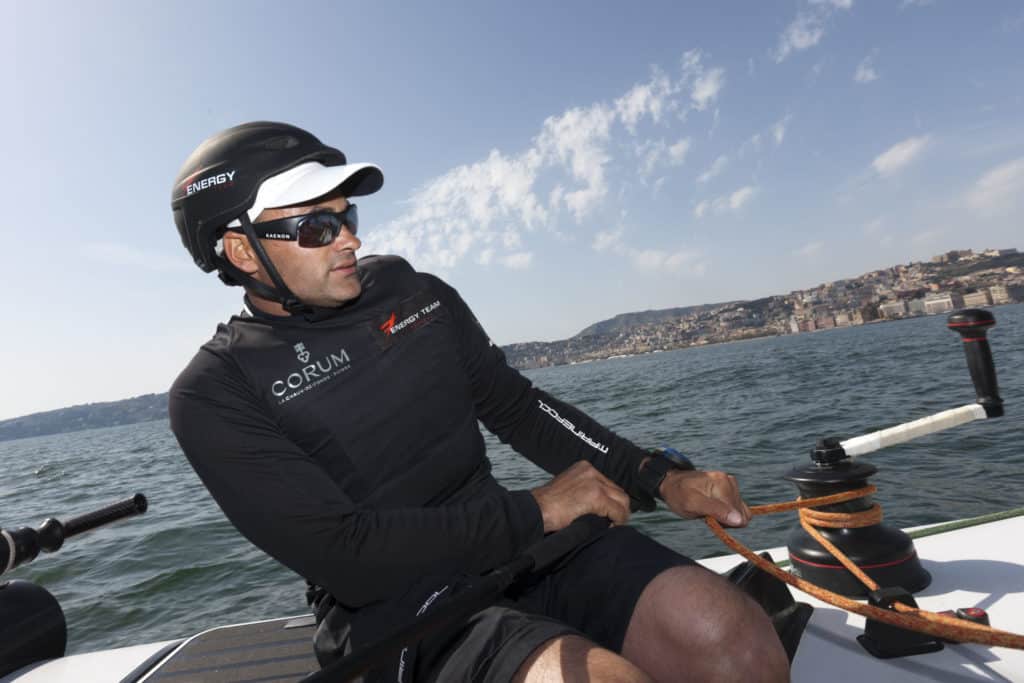
Yann Guichard
Yann Guichard says sailing in numerous transats has played a key role in the development of his multihull racing expertise for the America’s Cup World Series. After cutting his teeth against world-class competitors while finishing fourth at the 2000 Olympics in the Tornado, Guichard (38) transitioned into offshore multihull transats, finishing second twice in the Jacques-Vabre and winning the New York-to-Brest Krys Ocean Race on a MOD70 last year. Guichard acknowledges that his past experience in the Olympics has been very important for the ACWS, but says that the multihull skills he developed during his transats were essential for the circuit as well. The fact that the Frenchman has begun to make a name for himself as a helmsman for Energy Team’s AC45 during the ACWS serves as proof that the combination works.
How has your offshore experience helped onboard the AC45 in the America’s Cup World Series?
YG: You learn a lot more when you sail different kinds of multihull races, both inshore and offshore. If I had only done inshore racing before, then I would not be prepared to compete in the ACWS like I am today.
Solo offshore racing teaches you to wear several different hats. When you are alone in the middle of the ocean, you have to be an expert at everything and know every facet of the boat. That has definitely helped me to manage a team much better when sailing the AC45.
Is multihull experience crucial to success in the ACWS?
There are also people with no multihull experience who have learned very quickly, in six to eight months. It all depends on applying yourself. You can be good at monohull sailing and then switch to multihull sailing, and vice versa, but you need to spend a lot of time on the water to do that. Multihull sailing involves a lot of intuitive skills that you only learn while on the water. When sailing offshore on a multihull, which is very different than inshore racing, the intuitive part of the equation is important.
So a monohull sailor can learn to sail AC45s competitively in a relatively short period of time if they work hard enough at it?
It depends on the sailor. A good example of someone who has done that is James Spithill. Before competing in the America’s Cup, he had never sailed competitively on a multihull boat, but for a couple of years before he started, he ate, drank, and slept multihulls and competed in every multihull regatta that he could. And he certainly learned the ropes. Not everyone has the capacity to master the skills like he did, but his preparation was very intensive, and he spent a long time on the water to get where he is today.
How can a spectator tell whether a team is doing something right or wrong?
It is hard to notice when a team makes a false move, except for obvious things, such as when the sail begins to luff or the boat capsizes. Given the high level of talent in the ACWS, there are, of course, few occasions to witness such obvious errors. The errors are usually due to flaws in a strategy or tactic, which are less noticeable.
The start represents 80 percent of the race in the ACWS. Positioning is extremely important before the start. It greatly depends on the wind angle. [From the pin end] the distance to first mark can be shorter, but if the angle of the wind is not optimal, you can [start closer to the committee boat and] sail a course that is longer, but faster because the boat’s angle to the wind is optimal.
You study the angle of the wind at the pin, and if the true wind angle [relative to the bearing to the first mark] is less than 90 degrees to 100 degrees, you are going to lose speed compared to when you are at 110 to 120 degrees from the wind. We also make a few practice runs toward the buoy to see what the wind angle is there before the start.
The best direction to take also depends on the wind speed. If there is a lot of wind, you go fast at a 120-degree true wind angle, but if there is not a lot wind, then you go slower than you would if the true wind angle were 90 degrees. Analyzing these variables determines how you are going to position yourself at the start.
Then, you have to analyze the competition. If I start next to the Chinese team, for example, I know I have a better chance at gaining speed compared to if I start next to the New Zealand or Italian teams.
You mention capsizing, how do you avoid that when you’re pushing the boats so close to the limit?
I haven’t capsized yet in the ACWS, and this is where my offshore racing experience has been a factor. In an offshore race, capsizing can be deadly and you put your teammates’ lives in danger. So offshore racing is a constant exercise in risk calculation. You need to know when to take your foot off of the gas pedal because you are either going to break the boat or do something bad.
You also need to be in harmony with the boat when helming. I have been sailing multihulls for 20 years and have a developed a sense of how multihull sailing works. I can tell right away when the boat has reached its limit. It would be wrong to say that I will never capsize during an inshore race, but I have never capsized while sailing a boat larger than a Tornado.
How do you manage to maintain speed when tacking on an AC45?
You actually stop for less time tacking an AC45 as compared to the MOD70 trimaran. With the wing sail, the risk of stopping when tacking and losing a lot of speed when jibing is reduced.
It comes down to what you do before tacking. If you start the tack when the boat starts to lift, you are going to come to a stop. You are going to push the helm, the boat is going to land on the water, and you will have a hard time completing the tack. Ideally, you start to tack when you have a reached a maximum speed with the boat flat on the water. You push the helm gently at the beginning, and once you have passed in front of the wind, you push the helm harder so the boat builds up momentum to complete the tack.
Working with the wave conditions is key as well. For example, if there is a wave in front of you and you push the helm, things can go bad. You can stop or go backwards.**
**
What are your impressions of foiling on the AC45?
I am impressed by the speed when you fly. I try to avoid foiling when the boat is too high out of the water and instead try to foil close to the water. But others prefer that the boat remains higher from the water when foiling. This is a subjective thing, but I find that I sail faster when I do it my way.
What are the ranges of wind speeds that are optimal for foiling?
Six to 8 knots of wind speed is too light. Foiling is not a good idea when the wind is blowing at more than 25 to 26 knots, either.
There is a big, big difference when winds speeds change even slightly with the AC45. When the wind changes from 7 knots to 7.5 knots, for example, at a wind angle of 120 degrees, you can start to foil.
What advantages do the French have in consideration of France’s famous multihull expertise?
Sure, the French have dominated the offshore multihull scene for decades. But the other teams and nationalities have learned very fast leading up to the America’s Cup. In six months time, any extra know-how a French sailor might have had at the beginning was no longer relevant. It is incredible how fast the different teams have evolved. I mean the teams started foiling in just a few months, which is incredible.
Catamarans are fastest when the windward hull is just out of the water. Going upwind, how is that achieved on a large catamaran like an AC45 or AC72, when you are not able to make the instantaneous adjustments as you would on a small catamaran?
A multihull does not have a large and heavy keel to hold it down, and instead, you have a daggerboard to worry about. Going upwind is basically the same whether you are on a catamaran or a larger AC45 or an AC72, except on a catamaran, it is a lot easier to move or raise and lower the daggerboard. On a larger multihull, you have to pay a lot of attention to the position of the daggerboard and how the crew adjusts it. When there is not a lot of wind, you lower the daggerboard as much as you can to avoid drifting laterally. But as the wind becomes stronger and the boat gains speed, you then need to worry about raising the daggerboard because you will not be able to accelerate like you want if you do not do that fast enough.
The bear away to a downwind course is the most difficult move on a catamaran, especially in the AC45s and AC72s. What’s the secret to pulling this off without capsizing?
This is where experience becomes important. Also, when training, you try to push the boat to its limit without actually reaching the limit. The advantage that you have on a small catamaran is that when you crash, there is less risk of injury and to the boat, of course, compared to wiping out on an AC45 or an AC72. But on an AC45 or an AC72, you must always push the boat to its limits, and this is where experience comes into play when managing the crew, by making sure they lower the sails at the right moment, or set the sails just exactly right so you don’t crash. The person at the helm must know how to keep everyone out of trouble. But regardless of the size of the boat, whether it is a small cat or a large AC72, there is always a risk of capsizing. That is part of the game. There will always be accidents. We are not playing pool.
Passing is always a challenge in a match race. What is the key to getting around a boat on the America’s Cup course? Where do you expect we’ll see the passing occur?
You have exactly the same worries, regardless of whether your are on an America’s Cup course or not. Everyone knows how to go fast on a multihull, but the key is knowing how to maintain speed. It can go slow down quickly, just like it can accelerate very fast. The key is knowing what to do and when to maintain speed.
So when you want to pass someone, and there is a little bit of extra wind, you need to know how to first accelerate, by raising the daggerboard, putting on the cunningham, shifting the crew’s position on the boat, etc.
At the same time, one of the advantages of a multihull compared to a monohull is that if you do a small bear away of just five degrees, you are going to get a speed boost of 20 to 30 percent, compared to just a five-percent speed increase on a monohull. You really have to keep in mind you rapidly gain or lose a lot of speed, depending on the boat’s angle to the wind.
On an AC45 going downwind, you can pass someone quickly, especially when they make a mistake. When you see their gennaker starting to flap in the wind when going around a buoy, you know that you have good chance. These are the kinds of maneuvers where there is little to no margin of error, because if you make a mistake, someone is going to pass you.
With two AC72s sailing downwind on the foils, what will separate the two boats in terms of speed? Why or how will one boat be faster than the other?
The differences in the boat designs are important, of course, because one is inevitably faster than the other. But beyond that, there are many different details that come into play that will determine which boat goes faster. A faster boat is not going to do you much good if the crew members can’t take advantage of its potential. You need to know what the boat’s potential is, and you must also be able to know how to completely exploit that potential. That is what is difficult to do on a multihull, especially on an America’s Cup course, which is so short, and where you are constantly adjusting the sails. As soon as the boat reaches its maximum speed, it is time to tack. On a longer course, it would be easier to exploit the true potential of an AC72.
So when sailing downwind on the foils, the boat that goes faster is the one on which the helmsman knew when to accelerate at the right moment. The differences in speeds can be large and you can accelerate very quickly. That is the magic of large multihulls, which means that you can’t be certain of who is going to win until the fastest boat wins the race.

